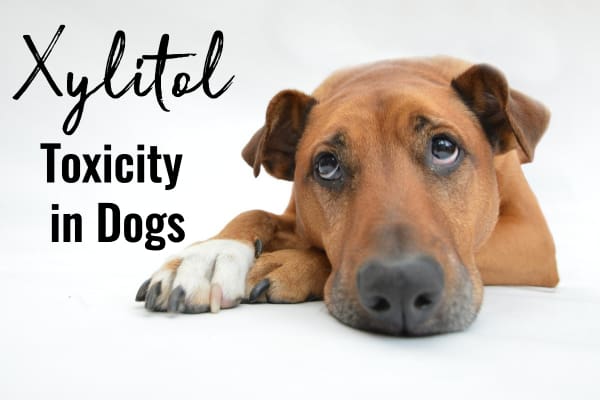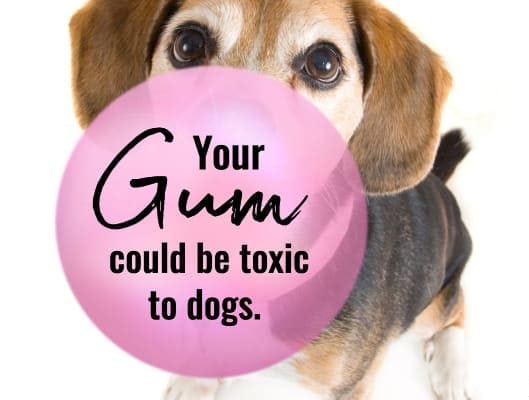Integrative veterinarian Dr. Julie Buzby warns about birch sugar (aka xylitol) as a danger for dogs. This artificial sweetener is found in everything from a piece of gum to peanut butter, which can be extremely harmful to dogs if ingested. Knowing how to identify birch sugar in foods and what to do if your dog eats some can help keep your pup safe from this common household danger.
According to the Pet Poison Helpline, cases of xylitol poisoning in dogs have more than doubled in the last five years. This artificial sweetener that also goes by the name of “birch sugar” is being added to more products, and many pet owners are unaware of the danger it poses to dogs. Keeping an eye on the ingredients in the products you buy could help keep your dog safe.
Is birch sugar xylitol?
Birch sugar and xylitol are one and the same. When companies started adding “birch sugar” on their product labels a few years ago, we saw an uptick in xylitol toxicity cases because some people screened labels for xylitol and weren’t aware that birch sugar is the same thing.
While xylitol has been around since 1891, it’s a fairly new health concern for dogs. Xylitol is a sugar substitute. It is a sugar alcohol found naturally in various plants and fruits.
Discovered by a German chemist, it was used during World War II because sugar was unavailable. As an alternative, they pulled xylitol out of hardwoods like birch trees to use as a sweetener. This is where the term birch sugar comes from.
The first xylitol gum (and sugar free chewing gum is certainly the most common culprit I see with xylitol poisoning in dogs) was launched in Finland and the United States in 1975. Now a myriad of products for human consumption include xylitol (birch sugar) as an ingredient.
What are other names for birch sugar (xylitol)?
To add to the dangers for our dear dogs, this toxin for dogs may be listed on product packaging under many other aliases. It may be listed as:
- Xylitol
- Birch sugar or birch sap
- Birch bark extract
- Wood sugar
- Xylite
- E967
- Meso-xylitol
- Sucre de Bouleau
With all these potential pseudonyms, noticing xylitol in some products can be tricky. Some packaging has words or phrases that might increase suspicion for xylitol, so make sure to closely read the ingredients on any products labeled such as:
- Sugar free
- No sugar added
- Low carb
- Naturally sweetened
- Aspartame free
- Anti-cavity
What products contain xylitol (birch sugar)?
If you walk down the grocery store aisle and read the labels, I think you’ll be stunned at how often you see xylitol (aka birch sugar or one of its many aliases) on the ingredient list. It’s in everything from toothpaste and mouthwash to pudding and peanut butter.
Xylitol in peanut butter: For your dog’s sake, read the label
Since peanut butter is a go-to choice for many dog parents as a way of disguising medicine for a dog that won’t take pills or simply giving a dog a special treat, it’s especially important to read the label on your jar of peanut butter.
Within the last several years, manufacturers have started including xylitol as a sweetener in some peanut butter brands. Unfortunately, this addition led to a number of dogs getting sick after consuming it. The last thing any dog parent wants to do is accidentally hurt his or her dog by unknowingly coating a pill in xylitol-containing peanut butter.
Xylitol can be commonly found in foods formulated for people with diabetes, since it has a lower glycemic index than sugar.

Here is a short list of human consumables that may include birch sugar. One of my veterinary colleagues, Dr. Jason Nicholas, has one of the most thorough lists of 700+ xylitol-containing products on the website, Preventivevet.com. It is astonishing how many products have xylitol in them!
Did you know these products may contain xylitol?
- Toothpaste
- Mouthwash
- Peanut butter
- Chewing gum
- Breath mints
- Candy
- Jellies and jams
- Cereals
- Baked goods
- Puddings and Jell-O®
- Cosmetics
- Lip balm
- Shampoo
- Syrup and honey
- Ketchup and condiments
- Drink powders
- Vitamins
- Nasal sprays
- Medications
- Ice cream
Remember that this is not an exhaustive list, and it’s very important to carefully read the ingredients of any human food item or medication you share with your dog.
Birch sugar in dental products
We may assume that an artificial sweetener would only be found in foods. However, many toothpastes and mouthwashes contain birch sugar. Some studies have found that xylitol may help prevent cavities in people. While that is exciting news for dentists, it puts veterinarians on guard for additional potential household dangers.
Along those lines, combatting dental disease in dogs is essential for their overall health. You should never use toothpaste formulated for humans on your dog. There are many options for dog-specific dental care products that are safe to use.

Prescription medications and pharmaceuticals for your dog may contain xylitol
While your veterinarian would never give your dog a medication that might harm him or her, some prescription medications used for humans contain xylitol. This may be a concern if your vet is prescribing a medication to be filled at a human pharmacy. Pharmacists that primarily dispense medications to humans may not know to be on the lookout for medication formulations that contain birch sugar.
Your veterinarian should be proactive in watching for medications containing xylitol, but an informed and vigilant pet parent can prevent a tragic mistake if xylitol is inadvertently overlooked.
Meloxicam human oral suspension is one example. Metacam is the veterinary comparable brand name drug. Some human generic meloxicam suspensions or syrups contain xylitol.
Another very common medication prescribed for pain is called gabapentin for dogs. The capsules and the tablets don’t contain xylitol, but many gabapentin liquid suspensions do. If you’re getting gabapentin suspension for your dog from a human pharmacy, check with your veterinarian and the pharmacist to make sure the brand being dispensed is safely xylitol-free.
Over-the-counter melatonin and xylitol
Also, veterinarians may recommend over-the-counter melatonin for dogs for various reasons. Melatonin in the fruit-flavored, rapid-dissolve tablets and the gummy version are likely to contain xylitol. Just a few of these could be toxic. Please be aware.
This is also a good reminder to keep any human medications safe from dogs. I know a lot of people who take melatonin themselves, so if you have a formulation that contains birch sugar at home, make sure to keep it out of your pup’s reach. Trust me, dogs can chew through pill bottles!
Why is xylitol bad for dogs?
Dogs ingesting xylitol face two major concerns: hypoglycemia and liver disease in dogs. Let’s take a look at each problem to answer the questions, “what does xylitol do to dogs” and “why is xylitol toxic to dogs.”
Hypoglycemia
Xylitol, a sugar substitute, “tricks” the dog’s body into thinking it has consumed sugar. When the body consumes sugar, the pancreas releases a hormone called insulin.
This is the same process in our own bodies after we eat a meal or a sweet snack. Sugars and carbohydrates in food raise blood sugar levels, and insulin keeps those levels from getting too high. It’s this delicate body balance that the brain maintains.

But herein lies the problem. The dog really hasn’t consumed sugar. There’s not a high blood sugar problem that needs to be counteracted. So, because the insulin drives blood sugar into the cells and out of the bloodstream, the dog ends up with hypoglycemia (i.e. low blood sugar).
If the blood sugar gets too low, seizures in dogs and even death may occur. In some cases, the drop in blood sugar happens fast. It can occur within 10 to 15 minutes after ingestion. In other cases, the symptoms may not appear for up to 12 hours after ingestion.
Humans metabolize xylitol differently than dogs, so we don’t have the same drop in blood sugar when we consume birch sugar.
Liver Damage
Damage to the liver, which can be very extensive and even fatal, is the second problem associated with ingestion of xylitol. Although the exact mechanism isn’t known yet, xylitol causes liver cells to die in some dogs.
Researchers theorize that xylitol may decrease cellular energy (i.e. ATP) stores in the liver cells and/or that it may cause oxidative injury to liver cells. Whatever the exact process is, the end result is acute liver failure.
Slow-release toxin
On top of this, some xylitol-containing products act as a slow-release toxin. Sugarless gum containing xylitol is an example. Sitting in the gastrointestinal tract, the gum slowly releases birch sugar, which continually drives the dog’s blood sugar down.
When dogs eat xylitol-containing gum, their blood sugar may continue to drop until the gum is removed from the gastrointestinal tract.
Gum doesn’t show up on X-rays, so unless an owner knows their dog got into gum, managing the dropping blood sugar may become a medical mystery for a veterinarian. The gum can sit in the stomach for hours. Unless the vet induces vomiting, the slow-release toxin in the gum may have devastating effects.
Signs of xylitol poisoning in dogs
Here are some of the most common signs and symptoms of xylitol poisoning in dogs:
- Vomiting—often the first sign noticed, and even if the dog vomits up the offending substance, that doesn’t mean he or she won’t continue to get sick
- Weakness
- Ataxia (uncoordinated stance or gait) or a wobbly and off balance dog
- Collapse
- Seizures or tremors. These symptoms are caused by the drop in blood sugar that may occur within just 15 minutes of ingestion.
- Icterus (jaundice)—yellowing of the gums, eyes, and/or skin. This is a sign of significant liver damage.
- Blood in stool
- Bruising or bleeding—liver failure can cause problems with blood clotting
- Neurologic complications due to the liver no longer filtering toxins from the blood
How long does it take for dogs to develop symptoms of xylitol poisoning?
The first signs, vomiting and effects of hypoglycemia, can develop within 10 to 15 minutes of ingestion. Typically, signs of liver damage may be evident within 9 to 12 hours, or can take up to three days to develop.
With such variable symptoms and onset of clinical signs, each case of birch sugar toxicity can be different. Severity of symptoms can depend on the size of the dog, the type of xylitol-containing product that was ingested, how much was ingested, etc. If someone tells you “my dog ate xylitol and is fine,” please do not let down your guard. If you suspect that your dog consumed birch sugar, seek emergency care right away.

What should I do if my dog eats a xylitol-containing product?
- Call the animal poison control center immediately. If possible, have the packaging in hand so you can give the most accurate information.
- The ASPCA animal poison control center is run by veterinary toxicologists. It is a good idea to keep the phone number handy. There is a charge associated with the call, but with xylitol toxicity, time is of the essence. You may be able to help your dog by gaining poison control’s advice while en route to your veterinarian.
- Contact your veterinarian or your local veterinary emergency animal hospital immediately for an emergency vet visit .
- If you’ve already spoken with a veterinarian at poison control, convey the information to your veterinarian. This may help your vet devise a more effective treatment plan.
How is xylitol toxicity in dogs treated?
Treatment for xylitol toxicity in dogs depends on how much xylitol they consumed, and how soon treatment is initiated.
Treatment may include:
- Hospitalization
- Induction of vomiting
- IV fluid therapy
- IV dextrose to increase blood sugar
- Repeated bloodwork
Depending on the severity of your dog’s condition, treatment may be expensive. But the cost of not treating may be your dog’s life.
If you’re wondering how to treat xylitol poisoning at home, the answer is: Don’t. This toxin can be fatal, even sometimes with treatment, so at-home remedies just won’t cut it. A dog who eats birch sugar needs emergency vet care right away.
What is the survival rate for xylitol toxicity?
Because there can be such a range in severity of illness caused by xylitol toxicity, a general prognosis is not predictable. The sooner the dog reaches the vet, the better the prognosis. Severity of liver damage does not necessarily correlate with how much birch sugar a dog ate.
Additionally, not all dogs show signs of hypoglycemia before their liver is affected. So if you think your dog got into a product containing xylitol, do not wait 30 minutes to see if signs of hypoglycemia develop. Your dog may need treatment STAT!
If a dog makes it to the vet very quickly after having eaten a product containing xylitol, he or she has the best chance of recovering. If a dog presents after he or she is already icteric due to liver failure, survival rate is not very high.
Prevention is the best medicine
Whether you call it birch sugar or xylitol, it’s becoming more and more prevalent in household products and human foods that we consume daily. Prevention truly is the best medicine. The following tips will help keep your beloved dog safe:
- Treat products containing xylitol like you would a prescription drug or a harmful substance. Just as you keep prescription drugs safely locked up, keep products containing xylitol out of reach of your dog. Even small amounts of xylitol can be harmful for dogs.
- Read product labels carefully. Educate yourself on what products in your home contain xylitol, and remember it can have several different names.
- For more information on xylitol and dogs, please check out my podcast, Xylitol Toxicity in Dogs. Guest speaker Dr. Jessica Taylor recounts the true story of saving a Goldendoodle name Sugar who ingested gum that contained xylitol. You can listen here:
Products containing xylitol and dogs don’t mix. Arm yourself and protect your beloved dog by finding out if you have this poison in your pantry.




Hello Dr Buzby, are all alcohol sugars in the same danger category as xylitol? I use a sugar free chocolate with maltitol. I’m guessing after reading the mechanism of action that you included (thank you for that) that it would have the same effect. Would you be so kind as to clarify this for me? Thank you for all you do for our fur babies! You have helped me navigate the often challenging and confusing world of aging canines and given me more quality time with my beloved companions. I am a nurse but many things do not translate to our animal family members. Your articles are life changing! Thank you, thank you, thank you.
Hi Annie,
What a great question! Thankfully other sugar alcohols do not cause the same clinical effects as seen with xylitol. But I would still keep your pup away from the chocolate as it is theobromine that causes the toxicity in chocolate. Thank you for bringing up this important topic!
My dog ate a 1/2 of a melatonin gummy before I could remove it and I saw it had this in it. Is he going to be Ok!!!!!!!! Im freaking out. No bad signs but Im sad he got it and reading is worrying me. Happened 2mins ago.
Hi Amber,
You are worried for a good reason! While your dog only consumed a small amount, this could still be an emergency situation. Please contact your vet or an ER hospital right away for further instructions. Praying all is well.
Can xylitol be passed to another dog if it eats the poisoned dog’s poop?
Hi Denise,
This is such a good question! My initial reaction was to say no. I think the xylitol would have been processed in the digestive tract and would not be in a form that could affect another pup if the feces was ingested. But to be honest I am not sure. I tried to find the answer and after doing some research could not find any mention of this exact situation. I will talk to some of my colleagues and see what they have to say. If I find anything on this topic, I’ll make sure to leave an update!
My dog did have an incident of xylitol poising by ingesting dark chocolate, He was treated and survived the incident. His liver enzymes are now ok. Can this poisonings cause any lasting damage? Can it cause seizures after a 1 1/2 time? He is a 10 1/2 year English Springer Spaniel.
Thank You
Hi Sandy,
I am glad your boy is doing ok after his dark chocolate incident. Luckily, any negative effects of the xylitol toxicity should be completely gone 2 to 3 days after ingestion of the xylitol containing substance. Xylitol causes the body to over produce insulin which drops the blood sugar to dangerously low levels. It is this low blood sugar that can sometimes cause seizures. So once the xylitol has been eliminated from the body and the blood sugar levels return to normal there shouldn’t be anything to cause a seizure. I hope this gives you some peace of mind!
Thank you so much for this information. I have not had a doggie for 7 or 8 years because my (now deceased) husband had breathing issues (COPD). AND, I just got a doggie yesterday!! So excited, so happy! I do not remember ever hearing this when we had dogs – so I really appreciate it!
Thanks, Donna
Hi Donna,
I am glad you found the information helpful. Congrats on your new pup! I wish you and your new family member the best. ♥
I just discovered xylitol as an ingredient in a shampoo I recently switched to. My dog will eat strands of my hair that fall on the ground and even though we do our best to clean up, we don’t catch them all. Is this something i should be concerned about? Since it is in shampoo, will it rinse out or does it absorb into my hair where it will cause a problem for my fur baby?
Hi Maggie, great questions and great job being vigilant! I can’t speak to what the shampoo will do in the hair, but perhaps you could call the manufacturer and inquire. In general, I’d be more concerned about a GI issue (ie. obstruction) from hair ingestion than I would be xylitol toxicity in this case, but you are very wise to be vigilant! ♥️
I have a 6 year old 10kg dog who fell suddenly ill and we suspect he may have xylitol poisoning as we did find teeth puncture marks in a tin that held tiny mints with xylitol. He started out yelping at the drop of the hat, any pet would send him, then he had a hard time getting up and then he wouldn’t move at all, Now he won’t eat and is having frequent seizures. Upon doing bloodwork (within minutes of a seizure) and testing his urine they found that he was severely dehydrated had elevated levels of bilirubin, and was moderately hyperglycaemic. 10.3 He did not have signs of real liver damage and being that his blood sugar was high after the seizure the vet ruled out Xylitol, (four days post ingestion) After a shot of anti nausea medication he still won’t eat and the seizures are becoming more frequent. (Like 4-6 a day) I have a T1D child so I know all well that a severe hypo can be followed by hyperglycaemia and I have read that sometimes dogs with Xylitol poisoning can present with Hyperglycaemia – but the question is: In a dog with Xylitol poisoning are the seizures caused exclusively by low blood sugar or can the toxicity affect the brain too? Thank you in advance as we are very puzzled!
Hi Rhonda,
I’m so sorry to hear of your dog’s recent illness. I don’t have to tell you how scary this can be!
This is a complicated situation and I would strongly recommend calling Pet Poison Control if you have not already: https://www.aspca.org/pet-care/animal-poison-control
They will be able to answer your questions in depth on mechanism of action for xylitol and help you rule out other possibilities as you seek to make a definitive diagnosis.
Please keep us posted! Thank you!
Is it safe to use face creams with xylitol in it if my dog licks my face all the time with his doggie kisses. Please I need to know if he’s safe. Love my dog. Thanks
Dear Ann, your question is an interesting one, because I don’t know how much face cream would be absorbed by your dog’s tongue that hadn’t already been absorbed by your skin. Nevertheless, I would NOT take the risk. I do not recommend using any products containing xylitol anywhere in your home (including on your face) where your dog can orally ingest them. It’s clear that you love your dog so much. I would not take any chances with xylitol.